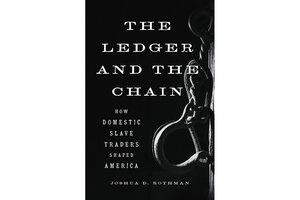Slave traders may not have been social outcasts after all
Historian Joshua Rothman uses the lives of three prosperous slave traders to explode myths about pre-Civil War American society.

"The Ledger and the Chain: How Domestic Slave Traders Shaped America" by Joshua D. Rothman, Basic Books, 512 pp.
Basic Books
At the heart of historian Joshua Rothman’s amazing, disturbing new book “The Ledger and the Chain” is the slaying of a persistent myth. Rothman looks at a typical view of pre-Civil War American society – that people North and South, in all walks of life, grudgingly accepted the presence of slave-traders in their midst but scorned them and considered them soiling presences in any civilized gathering – and he seeks to dispute and displace that view.
“Slave traders,” he writes, “worked in open collusion with legions of slaveholders, bankers, merchants, lawyers, clerks, judges, sheriffs, and politicians, who all recognized their indispensability, and as in most occupations, their standing, both in society and the business world, depended on perceptions of their integrity and reliability.” The claim that slave traders were reviled social outcasts was, he insists, mostly a myth.
In order to flesh out his case, Rothman makes the masterful dramatic stroke of putting three prosperous slave traders front and center: Isaac Franklin, John Armfield, and Rice Ballard. “The Ledger and the Chain” is in large part a biographical study of these men, both as individuals and as symbols of Rothman’s larger argument. Readers watch them preen and hustle and manage their finances, and although Rothman regularly reminds us that these men were very comfortable with “the intimate daily savageries of the slave trade,” he does an eye-opening job of making these three vile men three-dimensionally human. They gorge on onions, they dote on their families, they form deep friendships, all while engaged in “an undertaking as intricate as it was diabolical.”
The business of enslaving other human beings was highly lucrative. According to Rothman, in the first 60 years of the 19th century American slaveholders sent roughly 1 million Black people from the Upper South to the Lower South, a trade that dwarfed the size of the North American transatlantic slave trade from Africa. By 1860, Rothman writes, the market value of the slave trade was worth more than the country had invested in manufacturing, railroads, and banks combined.
And Rothman’s central and most damning point is that a mass of wealth and commerce so enormous could be laundered into many kinds of respectability if the broader society that benefited from it was willing to look the other way, to rationalize, and to accommodate. Franklin, Armfield, and Ballard were able to enter the finest emporiums and drawing rooms precisely because the industry of men like them helped to build those clean, well-lit rooms. “Their America incentivized entrepreneurialism, financial risk, and racial slavery, and no one made more of the junction among those things than they did,” writes Rothman about his unholy trio. “They became some of the richest men in the country as a result.”
The thoroughness of Rothman’s research occasionally seems to work against him. He asserts that the vast amounts of money commanded by men like Franklin, Armfield, and Ballard bought them acceptance in genteel Southern society. But his own narrative often gives the impression that most people they met in the course of their business dealings actually did scorn them. Maybe these men were just uncouth (or maybe it had something to do with all those onions), but it seems possible that there was also a deeper stain on their characters than Rothman is willing to admit.
In his own exhortative prose, that stain isn’t just professional – it’s intensely personal. Slavery wasn’t just merely what these men did, he insists, it was who they were. Being a slave trader required more than a simple willingness to hurt and terrorize enslaved people. “It required a commitment to those things, an enthusiasm for them … the collaborative pleasure they took in inflicting pain on the enslaved helped make them successful.”
That success was enormous, and as Rothman notes, it arose as much through ledgers and bills of exchange as it did through whips and chains. “We do not really understand American history if we do not understand the slave trade,” he writes, “and we do not really understand the slave trade if we do not understand those who made it work.”
“The Ledger and the Chain” is a stunning, unsettling account of a guilt shared more widely and more enthusiastically than many Americans like to think. Everyone knew what men like Franklin, Armfield, and Ballard did for a living, but their money spoke louder than their sin.

